
Catalog excerpts

Hip Joint Stem Type BEZNOSKA TRIO Primary Hip Joint Implants Femoral Components
Open the catalog to page 1
Implant Description Surgical Technique Implant Description Cemented stem with centralizer The centralizer ensures the balanced bone cement thickness from 1.0 mm to 1.5 mm. The thickness is determined by the sizes of rasp and stem (both). Characteristics of implants: Optionally, cemented or cementless stems can be used for implantation, depending on the type of stem. Cemented stems require combination with a centralizer. Cementless stem, Cementless modular stem. Cementless options allow for making a choice between a stem with fixed neck or modular one. Modular stems are set up with a range...
Open the catalog to page 2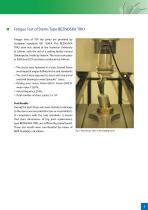
■ Fatigue Test of Stems Type BEZNOSKA TRIO Fatigue tests of TEP hip joints are provided by European standards ISO 7206-4. The BEZNOSKA TRIO stem was tested at the Technical University in Liberec with the aid of a testing facility named Elektropulse, made by Instron. The tests took place in 2009 and 2010 and were conducted as follows: ■ The stems were fastened in a basic braced frame and sloped at angles defined in the said standards; ■ The stems were exposed to stress with the aid of axial ball bearing to avoid "parasitic" stress; ■ Pulsing sinus stress: Fmin=200 N, Fmax=2300 N, mean value...
Open the catalog to page 3
Implant Description Surgical Technique ■ Introduction he complete assembly of the cementless total hip replacement is composed of the femoral component (stem and neck), head, and acetabular component (cup). The type TRIO and TRIO/HA cementless stem for total hip replacement is designed using expertise and experience with cementless implants, and can be used in a hip TEP assembly with any acetabular component (cup) and head, provided that the diameter of the hip TEP head corresponds to the internal diameter of the articulation insert, and that the stem, head and cup meet the requirements for...
Open the catalog to page 4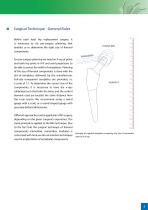
Surgical Technique - General Rules Before each total hip replacement surgery, it is necessary to do pre-surgery planning that enables us to determine the right size of femoral components. For pre-surgery planning we need an X-ray of pelvis and both hip joints in A/P and axial projections to be able to assess the width of metaphysis. Planning of the size of femoral components is done with the aid of templates, delivered by the manufacturer. Full-size transparent templates are provided, i.e. a scale of 1:1. To determine the correct size of the components, it is necessary to have the x-rays...
Open the catalog to page 5
Implant Description Surgical Technique Surgical Technique Femoral Component Implantation 1. Opening the bone marrow canal When using the posterior approach to the hip joint, it is advised to open the bone marrow canal with the aid of “T“ 28 head perforator 26 (Fig. 1). 2. Resecting the femoral neck After having disarticulated the hip joint head and inserted the suitable elevatory instruments 39 to 44 all the way up to the line where we intend to do the neck osteotomy, we take the oscillatory saw to perform the resection (Fig. 2). Note: Neck osteotomy can also be performed in situ without...
Open the catalog to page 6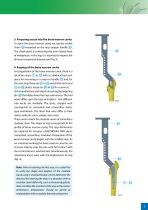
3. Preparing access into the bone marrow cavity To open the bone marrow canal, we use the wicket chisel 29 mounted on the rasp snapon handle 27. The chisel point is contouring the inner lateral facet of metaphysis. In this leg, it is essential to respect the femoral component anteversion (Fig. 3). 4. Rasping of the bone marrow cavity For preparation of the bone marrow canal, there is a set of ten rasps 1 to 10 with a cylindrical neck tailpiece for mounting in a snap-on handle 27 and, for the next step, there are 21 to 25 metal trial necks and 11 to 20 plastic heads (or 30 to 35 for...
Open the catalog to page 7
Implant Description Surgical Technique 5. First Trial Articulation The first-fitting procedures may vary, depending on the type of planned (preferred) component: a) If we want to apply a cemented or cementless stem with a fixed neck, we opt for a straight-neck rasp (135º/0º), selecting a metal trial neck 21 with a plastic head of the selected size (S, M, L, XL, XXL) and 11 to 20 diameter (or 30 to 35 for ceramics) (Fig. 5a). b) If a modular stem is used, we fit the rasp neck with the metal modular trial neck 22 to 25 and plastic trial head of the chosen size (S, M, L, XL, XXL) and 11 to 20...
Open the catalog to page 8
the distal end of the bone marrow cavity is to be closed (blinded) with a plug of cancellous bone tissue extracted with the aid of a tubular drill bit 57 . Insert the plug with the aid of the inserter 61 up to the very end of the bone marrow cavity/canal. Into the bone marrow cavity – properly flushed and thoroughly dried – we insert a Redon drain. Next, we fill the bone marrow cavity with a bone cement. While inserting the stem, we simultaneously remove the Redon drain. The stem is inserted with the aid of a guiding instrument that is fitted with a mobile positioning fork. The depth of the...
Open the catalog to page 9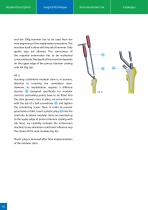
Implant Description Surgical Technique and the 300g hammer has to be used from the very beginning of the implantation procedure. The insertion itself is done with the aid of hammer. Only gentle taps are allowed. The correctness of the required anteversion has to be rechecked conscientiously. The depth of the insertion depends on the upper edge of the porous titanium coating with HA (Fig. 6b). Ad c) Inserting a definitive modular stem is, in essence, identical to inserting the cementless stem. However, its implantation requires a different inserter (45 designed specifically for...
Open the catalog to page 10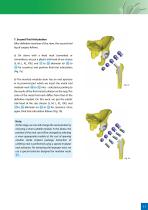
7. Second Trial Articulation After definitive insertion of the stem, the second trial leg of surgery follows. a) On stems with a fixed neck (cemented or cementless), we put a plastic trial head of our choice (S, M, L, XL, XXL) and 11 to 20 diameter (or 30 to 35 for ceramics) and perform final trial articulation (Fig. 7a). b) The inserted modular stem has an oval aperture in its proximal part which we insert the metal trial modular neck 48 to 52 into – selected according to the results of the first trial articulation on the rasp. The color of the metal trial neck differs from that of the...
Open the catalog to page 11All Beznoska catalogs and technical brochures
-
SKIN STAPLER 35W
1 Pages
-
Cementless cup – type SF
20 Pages
-
Radial Head Replacement
12 Pages
-
Humeral head resurfacing
12 Pages
-
Hip Joint Head Replacements
8 Pages
-
Cemented femoral stem - type CSC
16 Pages
-
Hip Hemiarthroplasty – type CSB
20 Pages
-
Cerclage System
12 Pages
-
UNIQUE MANUFACTURING METHOD
1 Pages
-
Implants for Traumatology
16 Pages
-
Revision systems
32 Pages
-
Implants for primary surgery
44 Pages
-
Individual oncological implants
24 Pages























